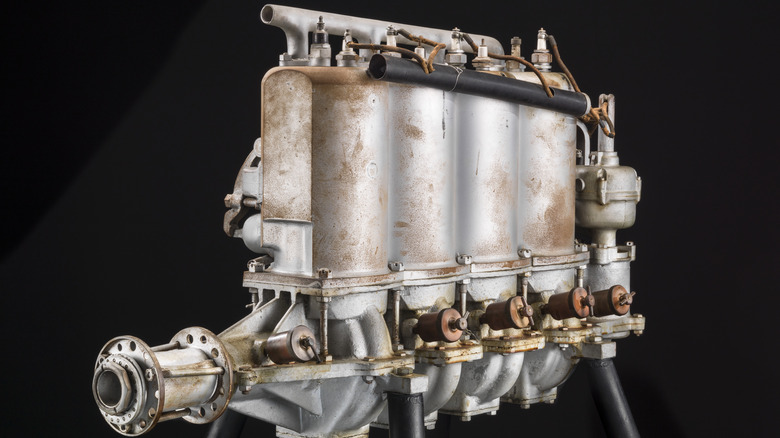Why Two-Stroke Engines Became A Thing Of The Past
The engine is possibly the greatest invention in the history of mankind. Generally speaking, engines are machines that convert one form of energy into mechanical energy and have revolutionized all sorts of industries. Early engines let ancient Greeks and Romans use cranes to load boats, and as time went on, technology improved. Inventors learned how to harness new sources of energy and channel existing forms of energy more effectively. With each new advancement, scientists created a new kind of engine.
Arguably, the most well-known engine, at least these days, is the internal combustion engine. These machines combine air and gasoline within a cylinder and use a spark of electricity to create high-pressure gasses that move pistons that, in turn, power different parts of the vehicle or connected device. Internal combustion engines revolutionized the transportation industry as they let people use personal and affordable vehicles, primarily cars, to travel vast distances in relatively short amounts of time. As more people purchased cars, engineers tried to make internal combustion engines that could do more with less gas. This march of progress rendered the first engine that powered the personal automobile, the two-stroke engine, all but obsolete.
What is a two-stroke engine?
As previously stated, internal combustion engines convert air and fuel into energy via, well, combustion, which essentially powers whatever the engine is attached to. Currently, internal combustion engines that use gasoline are divided into two-stroke and four-stroke engines. While their underlying mechanics are the same, factors such as mechanical complexity determine whether an engine is a two-stroke or not.
Internal combustion engines rely on a piston and a crankshaft. Whenever combustion occurs, the piston is pushed down, which rotates a crankshaft. The piston then rises, rotating the crankshaft even more. This process repeats ad nauseam so long as the engine is on. Since the crankshaft's rotation moves other crucial components, this process powers vehicles and other devices that house the engine, but it is also the main difference between two-stroke and four-stroke engines.
Every time a piston moves up or down — that is considered a "stroke." In four-stroke engines, the spark plug, which produces the zap of electricity that combusts the fuel/air combo, fires every four strokes (i.e., every other full crankshaft rotation). Meanwhile, in two-stroke engines, spark plugs fire every two piston strokes (i.e., every full crankshaft rotation). Moreover, two-stroke engines are smaller and lighter than four-stroke engines, lack the valves of other engines, and provide more power output for engines of their size.
In four-stroke engines, the air and fuel mixture only takes up the area of the cylinder above the piston, while in two-stroke engines, the mixture is present above and below the piston. Thanks to these factors, two-stroke engines are easier and cheaper to manufacture, which sounds like an advantage. However, these design elements were the main reasons why many modern countries and industries phased out two-stroke engines.
Two-stroke engines suffer from short lifespans
Since two-stroke engines have fewer moving parts, they are easier to manufacture, and logic would dictate they would be easier to maintain. That couldn't be further from the truth due to friction.
Whenever a car is in use, its pistons pump harder than any action humanly possible. While the exact number varies from car to car, the formula remains the same, and you are even looking at thousands of strokes per minute even when idle. Therefore, the amount of friction caused by pistons is immense, which makes the components wear down quickly. The same applies to rotors, gears, and other engine parts since the faster the piston moves, the faster everything else moves. You can (and should) lubricate your engines to keep them running as smoothly as possible for as long as possible, but even that solution has its limits, especially with two-stroke engines.
Four-stroke engines have a serious lubrication advantage since the air and fuel only inhabit the area above the piston. This design frees up the spaces and components underneath to be covered in a thick protective film of oil that stays in motion and keeps most of the moving parts lubricated. However, since air and fuel are present above and below the piston in two-stroke engines, oil needs to be added to that mixture via a balancing act.
Too little oil and metal grind against metal; too much oil and the fuel and air don't combust. Even when a two-stroke engine hits this Goldilocks zone of air, fuel, and oil, it still wears out faster than four-stroke engines because four-stroke lubrication is objectively more efficient.
Two-stroke engines require expensive oil
Every device that has an engine isn't a purchase; it's an investment. You should always consider the upfront cost, but it isn't half as important as the price of upkeep. Maintaining an engine with oil is a must, but even if you initially save money with a two-stroke engine, the cost of its oil will quickly outweigh that discount.
A small amount of oil goes a long way in four-stroke engines since they are built with pumps and filters that circulate and clean oil as it is used. You eventually need to replace your oil and filters, usually between one and three times a year, but unless something goes horribly wrong with your four-stroke engine, you don't have to spend a fortune on oil. Two-stroke engines, meanwhile, are veritable oil sinks.
As previously stated, due to their designs, two-stroke engines mix oil with fuel and air during each combustion stroke. To make sure the motor stays lubricated without disrupting the combustion process, two-stroke engines require low-viscosity lubricants that cost more than similar oils designed for four-stroke engines. But that isn't the biggest issue that will burn a hole in your wallet. After the combustion cycle, two-stroke motors expel the ignited ingredients, oil and all.
Since unused fuel or oil isn't recycled for later use (more on that in a bit), you have to regularly top up your engine with new oil. Maybe you mix it directly into the gas when refueling, or perhaps you fill up a separate oil tank. Either way, two-stroke engines burn oil in more ways than one, and your wallet takes the brunt of the result.
Two-stroke engines are less efficient
Gasoline is a limited resource, so many scientists are investigating ways to utilize alternate fuel sources or, at the very least, make engines run further on less gas. This pursuit has resulted in new kinds of engines, all of which have left the two-stroke engine in the dust.
One of the four-stroke engine's largest advantages is its compression ratio, i.e., the ratio of the engine's cylinder volume when its piston is at its lowest point vs. when the piston is at its highest. The larger the ratio, the more compact the air and fuel mixture becomes. Higher mix densities result in stronger and faster combustions, thus improving engine efficiency. Even when four-stroke and two-stroke engines are of comparable sizes, four-stroke engines generally sport higher compression ratios and are thus more fuel efficient.
Another issue holding back the two-stroke engine is its combustion cycle. Because of its simpler designs, these motors have to rely on pressure to expel the combusted materials every cycle. When the piston is at its lowest, a fresh mix of fuel, air, and oil forces the combusted mixture out, but because of how pressure works, some unburnt fuel might (and often will) escape out the exhaust, thus going to waste. Since two-stroke engines don't make the most of their fuel, they get fewer miles to the gallon when compared to four-stroke engines.
Two-stroke engines produce more pollution
Another issue constantly on automotive engineers' minds is pollution. Internal combustion engines burn gasoline and air, which release the results into the atmosphere, so they are a major source of harmful gasses in the atmosphere. More efficient engines burn cleaner and thus don't contribute as much to air pollution, but since two-stroke engines aren't efficient, they are generally worse for the environment.
As previously stated, lubrication is a big problem for two-stroke engines, so to keep them running smoothly, oil needs to be added to the fuel/air mixtures. When the engine's combustion stroke ignites, it isn't just burning gasoline and oxygen but oil as well. This, unfortunately, necessary additive makes two-stroke engines emit more and thicker smoke than four-stroke engines. Additionally, two-stroke engines are a large contributor to carbon monoxide pollution thanks to their burned oil. But air pollution isn't the only problem.
Since two-stroke engines tend to eject unburned oil and gasoline with every combustion cycle, the environment is gunked up by these discarded materials. In an early 2000s study, the National Park Service discovered that two-stroke boat engines disgorged anywhere between 25 to 30% of their fuel directly into the waters of Lake Mead, resulting in harmful levels of hydrocarbons.
In an unrelated study around the same time, the Oregon State Marine Board concluded that a decrease in two-stroke boat engines and an increase in four-stroke and electric boat motors contributed to lower hydrocarbon emissions throughout the state. While direct-injection two-stroke engines are more environmentally friendly than standard two-stroke, they still produce more pollution than other motors.
Where are two-stroke engines now?
Many manufacturers try to push improved engines on their consumer bases. The four-stroke engine essentially replaced two-stroke engines, while hybrid and electric engines are slowly but surely replacing four-stroke engines. However, for one reason or another, holdovers always persist. While four-stroke engines are objectively more efficient than two-stroke engines, not all industries and countries have adopted — or in some cases can adopt — the superior motor.
Today, two-stroke engines are primarily installed in small, low-power machines, including scooters, dirt bikes, lawnmowers, and chainsaws. The two-stroke engine's smaller size and weight don't overburden these devices or the people holding them, and the engine's relatively cheap manufacturing costs keep product prices down. While two-stroke engines are still used for larger vehicles in certain countries, these nations generally have loose pollution regulations or populations that have trouble affording more expensive four-stroke engine vehicles.
In 2004, Environmental Health Perspective released a paper regarding air pollution in Asian cities. According to the report, a whopping 75 to 80% of all vehicles in those urban areas utilized two-stroke engines, thus contributing significantly to heavy levels of smoke. To make matters worse, the study also claimed that many two-wheel vehicles had been converted into "baby taxis," which were larger and utilized three wheels via a sidecar.
These conversions still used the vehicles' original two-stroke engines, which worked harder and burned "even dirtier" under the extra weight. A separate study performed 10 years later found that two-stroke engines were still a significant source of pollution in Asian, African, and Southern European countries. Organizations such as the Asian Development Bank have suggested banning two-stroke engines to improve air quality in Asian cities.






